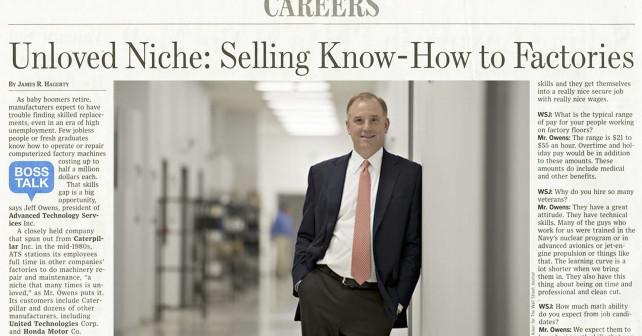ATS Featured in The Wall Street Journal

By James R. Hagerty, Wall Street Journal, June 2014
Jeff Owens, head of Advanced Technology Services, hires veterans and the mechanically and technically skilled for growing industrial companies.
As baby boomers retire, manufacturers expect to have trouble finding skilled replacements, even in an era of high unemployment. Few jobless people or fresh graduates know how to operate or repair computerized factory machines costing up to half a million dollars each.
That skills gap is a big opportunity, says Jeff Owens, president of Advanced Technology Services Inc.
A closely held company that spun out from Caterpillar Inc. CAT +0.23% in the mid-1980s, ATS stations its employees full time in other companies’ factories to do machinery repair and maintenance, “a niche that many times is unloved,” as Mr. Owens puts it. Its customers include Caterpillar and dozens of other manufacturers, including United Technologies Corp. UTX -0.73% and Honda Motor Co. 7267.TO -0.50%
ATS, too, must find enough highly skilled workers to keep clients happy. Mr. Owens focuses recruiting on the military; around a quarter of ATS workers are veterans. ATS also swoops in when factories close to hire the best workers, and the Peoria, Ill.-based company works with high schools and community colleges to ensure that students are picking up in-demand manufacturing skills, such as mastery of computer controls that operate factory machines.
The ATS workforce has expanded to 3,000 from 2,000 five years ago, and the company says it logs annual revenues of around $300 million, despite tepid 5% growth in 2013 as production slowed at some big customers, Mr. Owens says. The 48-year-old native of Muskogee, Okla., recently spoke with The Wall Street Journal about the outlook for manufacturing jobs.
WSJ: What’s your view on the future of U.S. manufacturing?
Mr. Owens: I’m optimistic. Here in the U.S. there is kind of a resurgence. Companies are feeling that they can be competitive with a plant that is located anywhere [else]. I don’t think people are accepting that [manufacturing] is going to be higher cost in the U.S. I’ve sensed a change in the past several years from a depressed, frustrated mentality to much more of an optimistic [mind-set].
WSJ: What are the main challenges facing ATS?
Mr. Owens: Finding very good skilled people, especially as we have retirements. It can create opportunities for us, but also can be a challenge. Another issue that we face is our health care costs, [which] have increased an average of 10% a year over the last five years.
WSJ: What will make ATS grow over the next five or 10 years?
Mr. Owens: Guys are retiring and not enough younger people coming up have those skills. A lot of people are coming to us and asking us for help.
WSJ: How serious is the skills gap in manufacturing?
Mr. Owens: For many years we’ve talked about a looming skills gap. I think you can take ‘looming’ off that phrase. What everyone thought was going to happen is happening.…There were some delays in retirements because of the economy but now retirements are happening, manufacturing is picking up and there is a lack of people.
WSJ: What are the best job candidates for you?
Mr. Owens: We hire for culture first—kind of the look and feel and the attitude—and then we work with them on the skills…. If they grew up on a farm, if they enjoy working on cars, that has been a very good fit for us.
WSJ: What if someone has never done any work with machinery?
Mr. Owens: We have programs for that. We work with local community colleges to get people into an environment where they can start understanding what the factory environment is like. We start from scratch and bring them along. The majority of our employees have had some factory experience in the past but to address the skills gap I think you have to have programs that can bring in people with no experience and go from there. We’ve had people who have been Realtors or musicians…And they’ve come in at a pretty low salary, and then they improve their skills and they get themselves into a really nice secure job with really nice wages.
WSJ: What is the typical range of pay for your people working on factory floors?
Mr. Owens: The range is $21 to $55 an hour. Overtime and holiday pay would be in addition to these amounts. These amounts do include medical and other benefits.
WSJ: Why do you hire so many veterans?
Mr. Owens: They have a great attitude. They have technical skills. Many of the guys who work for us were trained in the Navy’s nuclear program or in advanced avionics or jet-engine propulsion or things like that. The learning curve is a lot shorter when we bring them in. They also have this thing about being on time and professional and clean cut.
WSJ: How much math ability do you expect from job candidates?
Mr. Owens: We expect them to have basic math skills that you would have in high school. It’s surprising the lack of math skills that we [often] find even with people coming right out of school. We like to make sure they have the aptitude to learn.
WSJ: Does the rise of automation in manufacturing worry you?
Mr. Owens: Highly complex machinery fits into our strategy very well. When companies install high-tech equipment, many times there is more need for us [to keep the machinery running].
WSJ: What could the U.S. learn from China about manufacturing?
Mr. Owens: The aggressiveness of their workforce and their ability to learn is remarkable. They get off the clock and then they go to training. You see this desire to move up the food chain.

